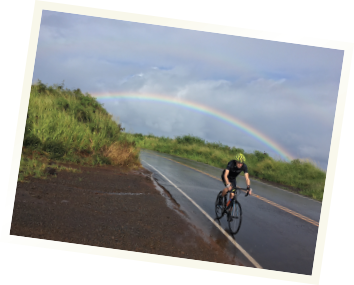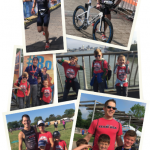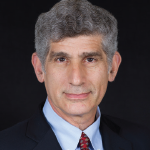
Dr. Simms loves competing in triathlons because it gives him the sense that nothing is impossible.
Every single morning—even on weekends—Robert W. Simms, MD, wakes up at 3:45 and is out the door by 4:30 to swim, run or cycle for at least one hour. After weekday workouts, he then heads to his job at Boston University (BU) School of Medicine, where he serves as professor of medicine and rheumatology section chief overseeing a research and clinical group.
Although Dr. Simms doesn’t have any sport trophies or medals adorning his office, he is the real deal when it comes to athleticism. He says his two grown sons believe he’s insane for maintaining this schedule for the past 20 years, but the USA Triathlon organization thinks otherwise. Every year over the past decade, it has ranked Dr. Simms as an all-American, recognizing him among the top 100 athletes in his age bracket based on his performance at his three best triathlons each calendar year.
“At last count, I had competed in over 120 triathlons,” says Dr. Simms. “I really like the training. The race is the motivation for doing the training and also the icing on the cake. It’s the journey to get there that really keeps me at this.”
Midlife Obsession
Dr. Simms says that when he was a child his mother realized he needed a physical release to stay focused in school. “I needed to be tired from physical exercise in order to put my best effort into my schoolwork,” he explains.
Although he says he was a technically competent swimmer in high school, Dr. Simms recalls that he barely qualified for the varsity swim team. He skipped more afternoon practices than he could count. He found downhill skiing much more fun. As he grew older, cross-country skiing took the place of downhill because it offered more in the way of aerobic activity. To stay in shape for the sport, he also started running and playing squash.
“While on the faculty at BU, I started competitive cross-country skiing (up to 30 miles),” he says. “But you couldn’t start [training] in the fall and expect to be competitive in the middle of the season if you weren’t spending serious time in the off season staying in shape.”
One day in 1998, a friend suggested triathlons as way to stay fit. On a whim, Dr. Simms, who was in his early 40s at the time, showed up at a local race with a rusty, 10-speed bike, borrowed wetsuit and worn-out running shoes.
“I didn’t make the podium for my age group, but I did pretty good,” Dr. Simms says. “I got really interested and wanted to do better. I decided I needed a new bike and wetsuit. Then it grew into an obsession.”
‘The race is the motivation for doing the training & also the icing on the cake. It’s the journey to get there that really keeps me at this.’ —Dr. Simms
Process Over Results
For more than 20 years, Dr. Simms has competed in triathlons all over the world, including 18 Ironman competitions, long-distance triathlon races that push people’s spirit, energy and ability to the edge with a 2.4-mile swim, 112-mile bicycle ride and 26.2-mile marathon run, raced in that order and—as if that weren’t enough—without a break. The average triathlete finishes the race in about 12 hours and 35 minutes. Dr. Simms’ time falls right in line—between 12 and 14 hours, depending on the weather, course, his health status and preparation for the race.
Over the years, he has worked with three different coaches, but is now self-coached. “Most coaches don’t understand the aging athlete,” says 63-year-old Dr. Simms, who also races mountain bikes and road bikes, and competes in a new sport, gravel racing (racing bikes on dirt roads). Most coaches “don’t give you enough recovery time from training. I learned by trial and error what I need to do to get to the starting line in one piece without getting injured, overfatigued or burned out. The major thing is having fun during training.”
Competing extends beyond fun. Every time he crosses a finish line, he says he feels a tremendous sense of accomplishment and confidence that he can overcome anything that life throws his way. It keeps him on an even keel, he says, and puts everything into perspective.
“Competing in any Ironman triathlon really gives you a sense that nothing is impossible,” says Dr. Simms, who traveled in June 2018 to Nice, France, to compete in another triathlon. “You have to relish the journey more than the outcome in order to have fun and keep doing this over a long period of time.”
Carol Patton is a freelance writer based in Las Vegas.
Neurology vs. Rheumatology
1980: Graduated from the University of Rochester School of Medicine and Dentistry
1981: Completed internship at Weill Cornell Medicine
1982: Completed first year of residency at Weill Cornell
1982–1984: Served as a general internist in underserved areas of Boston for the National Health Service Corps
1984–1985: Completed residency at Brigham and Women’s Hospital
1987: Completed rheumatology fellowship at Boston University
1988: Joined the faculty at Boston University
“I originally wanted to become a neurologist because of the diagnostic hunt, or chase,” says Dr. Simms, who also completed a mini-fellowship in rheumatology as part of the National Health Service Corps program. “But brain scanning, which figured out where somebody’s tumor was in a matter of seconds, almost put neurologists out of business. So I got very interested in rheumatology, which is also a diagnostic challenge. I also liked the idea of having long-term relationships with patients and making a difference in their lives by understanding them, the impact of their disease and designing appropriate treatment.”



